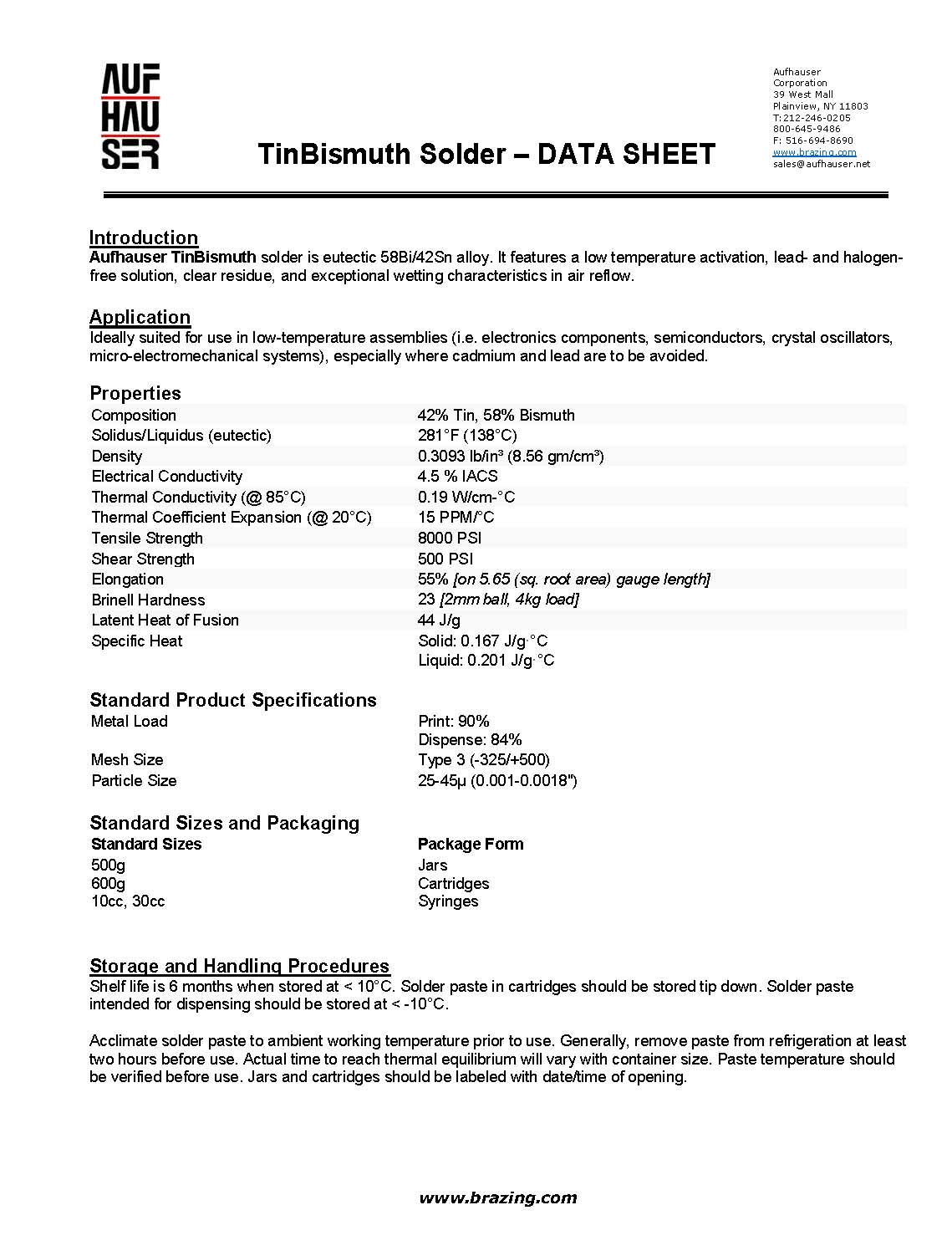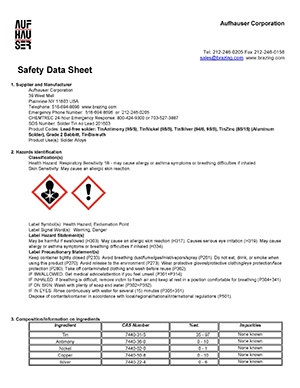INTRODUCTION
Aufhauser TinBismuth solder is eutectic 58Bi/42Sn alloy. It features a low temperature activation, lead- and halogen-free solution, clear residue, and exceptional wetting characteristics in air reflow.
APPLICATIONS
Ideally suited for use in low-temperature assemblies (i.e. electronics components, semiconductors, crystal oscillators, micro-electromechanical systems), especially where cadmium and lead are to be avoided.
GENERAL INFORMATION
Properties
| Composition |
42% Tin, 58% Bismuth |
| Solidus/Liquidus (eutectic) |
281°F (138°C) |
| Density |
0.3093 lb/in³ (8.56 gm/cm³) |
| Electrical Conductivity |
4.5 % IACS |
| Thermal Conductivity (@ 85°C) |
0.19 W/cm·°C |
| Thermal Coefficient Expansion (@ 20°C) |
15 PPM/°C |
| Tensile Strength |
8000 PSI |
| Shear Strength |
500 PSI |
| Elongation |
55% [on 5.65 (sq. root area) gauge length] |
| Brinell Hardness |
23 [2mm ball, 4kg load] |
| Latent Heat of Fusion |
44 J/g |
| Specific Heat |
Solid: 0.167 J/g·°C
Liquid: 0.201 J/g·°C |
STANDARD PRODUCT SPECIFICATIONS
| Metal Load |
Print: 90%
Dispense: 84% |
| Mesh Size |
Type 3 (-325/+500) |
| Particle Size |
25-45µ (0.001-0.0018") |
STANDARD SIZES AND PACKAGING
| Standard Sizes |
Package Form |
| 500g |
Jars |
|
600g |
Cartridges |
|
10cc, 30cc |
Syringes |
STORAGE AND HANDLING PROCEDURES
Shelf life is 6 months when stored at < 10°C. Solder paste in cartridges should be stored tip down. Solder paste intended for dispensing should be stored at < -10°C.
Acclimate solder paste to ambient working temperature prior to use. Generally, remove paste from refrigeration at least two hours before use. Actual time to reach thermal equilibrium will vary with container size. Paste temperature should be verified before use. Jars and cartridges should be labeled with date/time of opening.
ADDITIONAL INFORMATION
Printing
Stencil Design:
Electroformed and laser cut/electropolished stencils produce the best printing characteristics. Stencil aperture design is a crucial step in optimizing the print process. The following are a few general recommendations:
- Discrete components - 10-20% reduction in stencil aperture area may significantly reduce or eliminate the occurrence of mid-chip solder beads. The "home plate" design is a common method for achieving this reduction.
- Fine pitch components - Surface area reduction is recommended for apertures of 20 mil pitch and finer. This reduction will help minimize solder balling and bridging that can lead to electrical shorts. The amount of reduction necessary is process dependent (5-15% is common).
- A minimum aspect ratio of 1.5 is suggested for adequate release of solder paste from stencil apertures. The aspect ratio is defined as the width of the aperture divided by the thickness of the stencil.
Printer Operation:
The following are general recommendations for stencil printer optimization. Fine-tuning may be necessary based on specific process requirements:
- Solder paste bead size: 20-25 mm diameter
- Printer speed: 25-100 mm/sec
- Squeegee pressure: 0.018-0.027 kg/mm of blade length
- Underside stencil wipe: once every 10-25 prints
- Solder paste stencil life: >8 hours @ 30-60% R.H. & 22-28°C
Cleaning
TinBismuth is designed for no-clean applications. Yet flux may be removed if necessary by using a commercially available flux residue remover.
Stencil cleaning is best performed using an automated stencil cleaning system for both stencil and misprint cleaning to prevent extraneous solder balls. Most commercially available stencil cleaning formulations including isopropyl alcohol work well.
Reflow
Heating Stage: Linear ramp rate of 0.5° - 1°C/second allows gradual evaporation of volatile flux constituents and prevents defects such as solder balling/beading and bridging as a result of hot slump. This also prevents unnecessary depletion of fluxing capacity when using higher temperature alloys.
Liquidus Stage: Peak temperature of 25° - 45°C above the melting point of the solder alloy is needed to form a quality solder joint and achieve acceptable wetting due to the formation of an intermetallic layer.
Cooling Stage: Rapid cool-down is desired to form a fine grain structure. Slow cooling will form a large grain structure, which typically exhibits poor fatigue resistance. The acceptable cooling range is 0.5° - 6.0°C/second (2° - 6°C/second is ideal).
|


